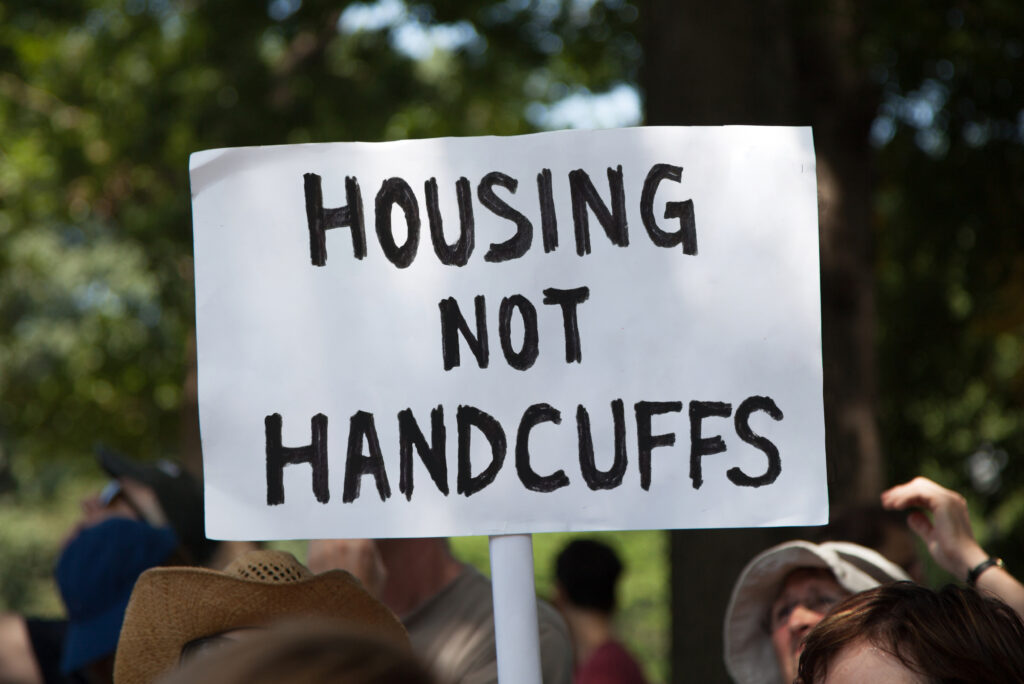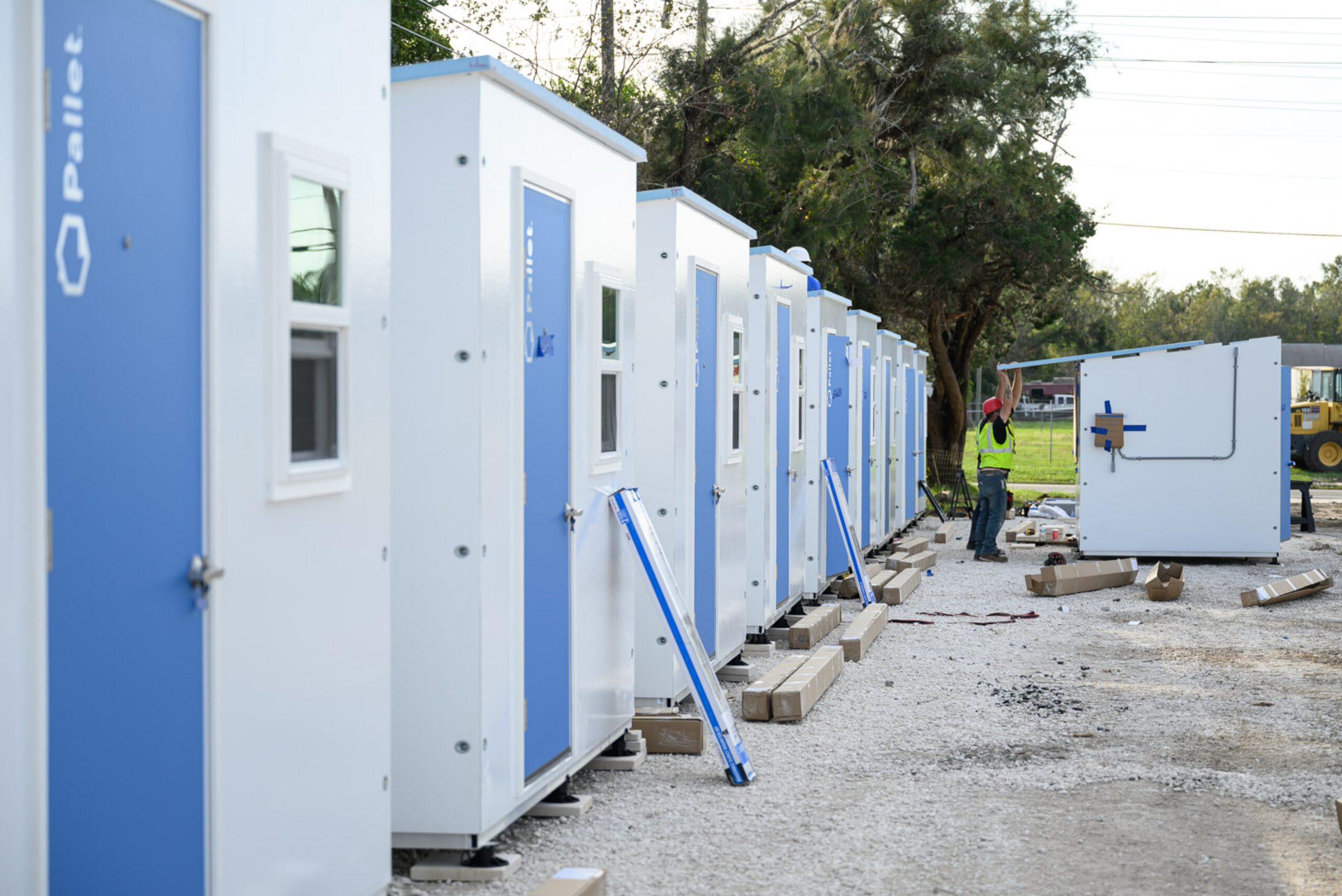Incarceration Is Not a Solution
July 3, 2024
Treating homelessness as a crime is costly, ineffective, and does nothing to solve the root causes of this crisis. Now, more than ever, is the time to invest in real solutions.

Communities have long understood the implications of criminalizing homelessness. Even so, recent state- and federal-level policies—which permit incarceration as a response to people living outdoors in public spaces—ignore the fact that this approach is not a solution. Rather, it perpetuates cycles of poverty, addiction, incarceration, and, ultimately, homelessness.
Reenforcing this broken system is as costly as it is ineffective. Not only will parks, recreation trails, and city streets continue to be misused, taxpayer costs will spike due to increased encampment sweeps and putting unhoused individuals in jail and prison.
It’s long overdue to focus efforts and funding on real solutions: provision of stable shelter, housing, and supportive services that enable vulnerable populations to contribute to the economy and community at large.
Perpetuating Ineffective and Unjust Systems
Current policies seeking to justify the criminalization of homelessness willfully ignore the failure of past efforts. Punitive measures including incarceration, encampment sweeps, and implementing cruel initiatives like hostile architecture simply propagate a broken system that pushes unhoused individuals further from stable housing and employment.
A significant part of this inefficacy is the fact that incarceration is, in many cases, a direct path to becoming unhoused. This “revolving door” effect has long been observed. Findings indicate that while a person who has been incarcerated a single time is nearly seven times more likely to experience homelessness compared to the general public, if that same person is jailed a second time, the rate spikes to 13 times higher. This means that if people are incarcerated on the grounds of living unsheltered multiple times, they are virtually guaranteed to return to the streets upon exiting the prison system.
Encampment sweeps, or the municipal practice of clearing public spaces of tents and other temporary or improvised structures, share the same level of ineffectiveness. When people living in these unsanctioned camps are forcibly moved, they often will relocate to another site. This of course accomplishes nothing but moving unsheltered groups from one location to another. A recent example in Washington D.C. illustrates this reality: after clearing out roughly 74 people living in McPherson Square, an estimated two-thirds of the group were still believed to be sleeping on the street.
It is fair that community members want to preserve their parks and recreation areas, especially considering they are not designed as living spaces and often lack adequate hygiene facilities, running water, and waste disposal services for unsheltered communities. However, when no alternative options are offered in conjunction with sweeps, the same displaced populations are likely to return to previous encampment sites.
As evidenced, the only true actionable solutions are building more affordable housing to mitigate the shortage of over 7 million rental units and creating broader, more equitable service programming for vulnerable and low-income populations. Offering transitional models such as emergency interim shelter with integrated service provision is another underutilized approach that creates pathways to more permanent housing. Incarceration, sweeps, and all other punitive approaches unequivocally fail to address these root causes or any of the conditions that exacerbate chronic homelessness such as substance use disorder, institutional racism, and generational poverty.
Futile Allocation of Public Funds
In addition to being ineffective and inhumane, incarceration (and the municipal, administrative, and reverberating economic costs associated with it) is far more expensive than simply building more housing. Many cities across the U.S. have reported dramatic cost savings to taxpayers when a focus was placed on providing more housing rather than cycling unhoused populations through jails, prisons, and the healthcare system.
One report released by the NYC Comptroller’s Office that shows the daily costs per-person of different approaches displays the cost-effectiveness of housing provision: compared to the $68 and $136 daily operating costs of permanent supportive housing and emergency shelter, respectively, one day of incarceration at Riker’s Island costs $1,414 and one day of hospitalization costs $3,609.
Another example in Denver indicates a similar trend. The study focused on individuals experiencing chronic homelessness who were in frequent interaction with the criminal legal system and emergency health services. When that group was enrolled in a city-operated supportive housing program, annual per-person costs for public resources such as jail, the court system, police, and emergency medical services lowered by $6,876.
Truthfully, the societal costs of incarceration go much deeper than daily operations and administrative fees. An estimated $370 billion each year is lost for people who have a criminal conviction or have spent time in prison—an enormous sum that could be spent on educational opportunities, buying a home, or a number of other economic investments that foster growth and community improvement. And when considering the massive amount of consequential loss associated with incarceration due to forgone wages, adverse health effects, and developmental challenges of children with incarcerated parents, the aggregate cost burden is believed to be roughly one trillion dollars.
These studies are incontrovertible proof that substituting jail and prison for housing is a gross misappropriation of taxpayer dollars, while providing no observable positive effects on solving homelessness.
True Solutions are Rehabilitative, Not Punitive
For years, it has been evident that real solutions focus on rehabilitating vulnerable populations, not jailing them. Time and time again, it’s shown that the solution is cheaper—fiscally and societally—than the problem. Comprehensive research has proven that criminalizing homelessness is expensive, wasteful of limited public resources, and harmful to public health and safety.
Now is the time to focus our collective efforts and funding on real solutions: creating broader shelter and housing models alongside comprehensive supportive services for displaced populations. Only then will we be able to observe progress in ending this crisis and restoring equity, safety, and dignity to our communities.


